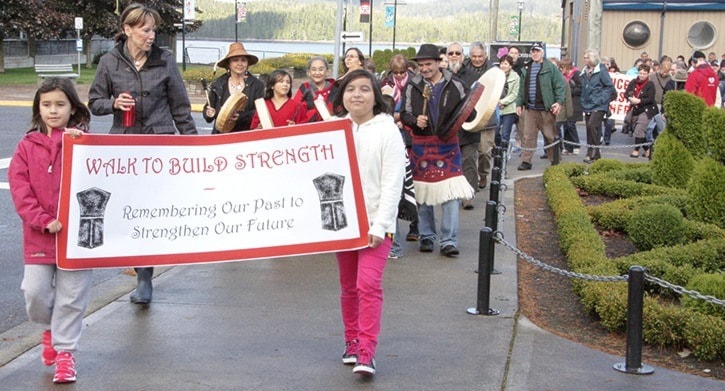More than 50 people took steps to move forward in the Walk to Build Strength on Saturday.
The event was held to reconcile relationships between aboriginal and non-aboriginal people by creating understanding about the impact residential schools had on aboriginals across the country.
"The most important message [of the Walk to Build Strength] is that our history is a shared history. It's not just the history of aboriginal people, it's Canada's. We need to remember that. As we continue to support our families and communities who work to deal with the healing and the impact of residential schools, it's not just those people's responsibility. It's everybody's," said Debbie Leighton-Stephens, who organized the event along with Marilyn Bryant, Reagan Sawka and Robert Etzerza from the Aboriginal Education Department of the Prince Rupert's School District.
"Sometimes we hear, 'that happened a long time ago, can't we just move on?'. No, it's not that easy," she said during a speech on Saturday.
Approximately 150,000 aboriginal youth across Canada attended residential schools, which were primarily active from the 1870s until 1996. The schools were funded by the Canadian government's Department of Indian Affairs and run by churches to abolish First Nations, Metis and Inuit traditions. Many students endured physical, sexual and emotional abuse during their time in residential schools.
The event also honoured victims and their strength for moving forward.
"As aboriginal people we overcame the government's pull to eradicate our [heritage]," Leighton-Stephens said.
Participants peacefully walked from Mariner's Park to the Fishermen's Hall for an event that included cultural dancing, music and speeches from residential school survivors.
Helen Johnson, who attended residential school as a child, spoke about her experiences and healing journey.
"All the abuses you can think of the majority of our children have gone through. I, for one, have been sexually abused, and I'm not afraid to say it. I stand tall today and honour myself for coming through such an abuse. I'm hoping and praying that all those that are still affected know there's hope at the end," she said.
Johnson said fellow residential school students were from all over the country, so they weren't able to communicate in their native languages.
"Children were taught, I for one was taught, to not honour my family or my culture," she said.
In the 1960s Johnson began researching her heritage, and today knows the culture that was taken away.
Johnson said while aboriginal people are strong, the struggle is still not over.
"Today we still feel the effects that were bestowed upon us. The new generation is affected today," she said.
"We need to build the bridge that was broken. We need to walk together with openness, dignity, understanding and hope."
Charlie Carlick also shared his experiences with moving forward in his life. Carlick was sent to residential school when he was six years old, spending 10 years in the system.
"I suffered much as a child. I was abused physically and they told me I would never learn. So often in the classroom [I was told I was] an empty barrow," he said, adding he felt insecure about the colour of his skin growing up without understanding why.
Carlick said in the years following residential school he wasn't sure who he was, and became an alcoholic for a number of years.
"It was because I was covering up so many things in my life. I had such deep insecurity," he said.
When he was 40, Carlick turned his life around, becoming sober and a Christian. Since finding his new path, he was able to find forgiveness.
"For years I was a prisoner in my own body. The worst thing is to have animosity, hate ... I learned unless I forgive I will remain in jail. Once I let go, I was free. I didn't hate them anymore, I hated what they did to me."
Following speeches, those in attendance lit candles to remember those who lost their lives in residential schools. At least 3,000 aboriginal children died in Canadian residential schools, mainly of disease.
Prior to Saturday's event the Aboriginal Education Department and planning committee went into four schools to discuss facts and history of residential schools with teachers. Carlick and Johnson shared their stories with teachers and discussed how residential schools are still impacting communities today.
Leighton-Stephens believes the workshops, along with educational material the Aboriginal Education Department provides, will make a difference in classrooms.
"That's going to make a difference because [teachers] will be more confident to incorporate that history into the teachings into the classroom," she said.
The walk and the gathering were held in recognition of Residential School Truth and Reconciliation week in Vancouver.
